Unreleased After Dark Modules
This isn’t fair!
This page shows some images from After Dark modules that I have written, but never released for various reasons; namely lack of time to polish them up, they are buggy as hell and I don’t have time to fix them, or they only run well on my 160 MHz Power Mac 8500 ;-)
How can I get them
You can’t. Well, if you really want to know how one works, you could email me, but I don’t guarantee that I will respond.
Mould
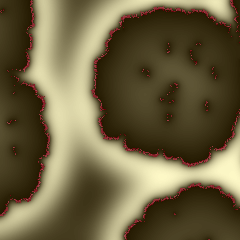
Mould is not a good name for this module, which more closely simulates bacteria. It consists of a population of cells, one per grid cell, living on top of a substrate which diffuses under them. Cells absorb and metabolise this foodstuff, and replicate (into a neighbouring empty cell) when their internal food reserves are sufficiently high.
Belousov-Zhabotinski
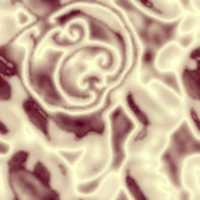
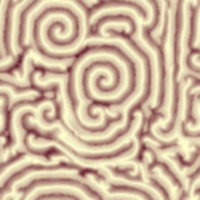
This 2D cellular automata approximates the spiral wave patterns observed in the BZ reactions (as well as many other reaction-diffusion systems), with an averaging-increment rule over 8-cell neighbourhoods. It took a bit of tweaking to get spirals, but the results are quite pleasing.
Conway’s Life

This is of course an implementation of Conway’s Game of Life, with cells coloured by age (blue -> red with ageing). Speed was my main goal here; the Power PC version runs pretty fast on a 512 x 512 grid.
Dripping Rail
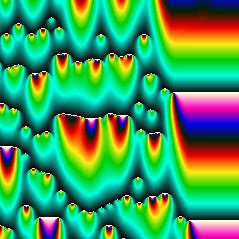
The Dripping Rail rule is a 1D CA rule which is simply an averging over neighbours and an increment. This module shows the time progression of the CA.
Eulerian Walkers
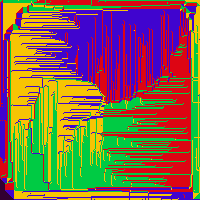
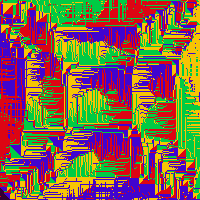
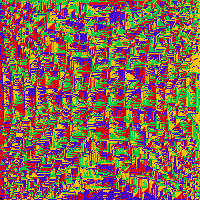
The patterns here are formed by little automata walking over a grid of arrows, and changing arrows at they go. Each cell in the grid has an arrow pointing in one of the four compass directions. Drop in a walker at a random spot, let it follow the arrow, then change the arrow in the destination cell 90 degrees clockwise. It then follows that arrow, rotates the next one etc. When it falls off the edge of the grid, another walker is dropped in at a random location.
Flames
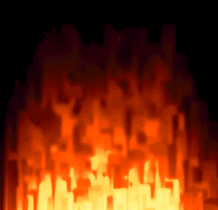
Fairly realistic flame patterns can be generated with a 2D CA rule which uses an inverted T-shaped neighbourhood, averaging over the cells in that neighbourhood with some decrement ( = cooling).
Snow

These nice fractal branching patterns are formed by aggregation of the falling particles.
Pickover
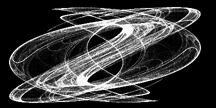
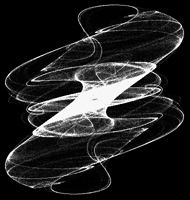
Cliff Pickover’s books are well known for their variety of interesting pattern-forming systems. These images are produced by iterating a transformation on the X-Y plane, the wavy patterns being produced by the sine and cosine operations in the transformation.
RAMView
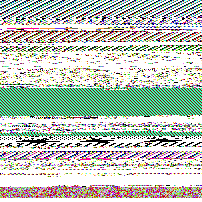
A module which simply shows your computer’s RAM graphically on the screen, and scrolls through from low to high memory. It’s interesting to see what lurks in there…
Freeway

This module simulates…well, a Freeway. Drivers each have a preferred speed, and follow some basic rules about when to overtake, speed up or slow down. Like real freeways, traffic jams are fairly common.
Logistic Map
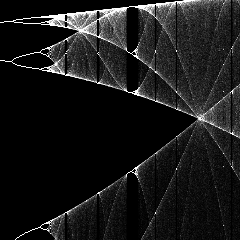
This is a section of the well-known logistic map. This means of displaying it, however, is not so common, and reveals a lot of structure in the areas which are usually portrayed as a solid mass of points. The technique simply increments the colour of a point the more times it is hit.
permalink | computing/archaic/afterdark | 2007.11.19-22:33.00
After Dark Modules
The inspiration
These modules share somewhat of a common theme, and are intended to be more than just ways of making pretty pictures. They draw inspiration from the fields of dynamical systems, artificial life and chaos, and are all simulations in which simple rules give rise to complex behaviour or pattern formation. Where applicable, these rules act locally — for example in Buzzz!, each boid only consults a few nearest neighbours when setting its heading. In Autumn Leaves, there is no interaction between the leaves, but they are acted on by a force local to their current position.
A second inspiration here is to reproduce those patterns seen in nature, with such simple rules. Bird flocking (as in the bird option in Buzzz!) and leaves blowing in the wind are obvious examples. There is also a large class of cellular automata models which are designed reproduce natural phenomena, though these are less amenable to implementation as screensavers because of speed constraints.
If you are interested in programming your own After Dark modules for the Macintosh, I have some AD programming information online.
I am always on the lookout for candidate systems to add to this collection of ‘simple rules give complex behaviour’-type modules. If you have an idea of a possible system, I would be happy to hear about it.
I also have a page showing some of the modules that I have written, but never released for various reasons. [Warning — it’s graphics-intense.]
 Buzzz! 1.4
Buzzz! 1.4
An After Dark module for the Macintosh, simulating swarming insects with rendered graphics and something similar to Craig Reynolds’ flocking algorithm in Boids.
Here’s what they’ve said about it:

- “Man! it’s SU-GOI! (A Japanese word for Far-Out!). Best AD module I’ve ever seen!”
- “I don’t know if I can convey to you the wonder I felt, watching your perch swimming around on my screen. I honestly have tears in my eyes. They are magnificent. I do not own, nor have I ever seen any other program that captures such startling beauty.”
- “…the best no-nonsense, simulation type AD module ever written.”
- “Buzz is cool, good graphics although no one gives a flying shit on whether the patterns of the bugs flight paths are correct!”
Available from:
 Mazin’ Shapes
Mazin’ Shapes
An After Dark module for the Macintosh, drawing colourful graphics by iterating a simple transformation.
Here’s what they’ve said about it:

- “Wow! What a great screen saver module! I just wanted to drop you a line and say how much I enjoy having Mazin’ Shapes on my monitor.”
- “Nice job! Very entertaining.”
Available from:
 Morphin’ Shapes
Morphin’ Shapes
This module is based on the same algorithm as Mazin’ Shapes, but changes one of parameters in the equations on the fly, causing the amazing and colourful patterns to merge, one into the next.
Because this requires some serious floating-point performance, this module only runs on Power Macintosh computers.
Here’s what they’ve said about it:
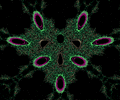
- “Morphin Shapes is really cool!!”
- I really enjoy your After Dark screen saver, Morphin’ Shapes”
Available from:
 Autumn Leaves
Autumn Leaves
Autumn Leaves generates beautiful swirling patterns, like leaves in a breeze. It actually simulates the motion of particles in a discontinuous vector field, and gives remarkably interesting behaviour despite the simple underlying mechanism.
This module runs on all Macintosh computers with Color QuickDraw. A fat module, and one compiled to make use of the FPU on some 68k Macs, are included in the package. It uses direct-to-screen drawing for speed, though this can be optionally disabled.
Here’s what they’ve said about it:
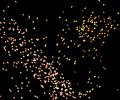
- “Wow. Autumn leaves is the most awesome third-party AD module I’ve seen.”
- “…it’s the coolest module I’ve seen. I can see right now that I’m never going to get any work done and will probably soak my wristpad with drool. It’s amazing!”
Available from:
 Poincaré
Poincaré
Poincaré is an After Dark module for the Macintosh, that demonstrates Poincaré’s recurrence theorem. Essentially, that means that if you apply a transformation (to an image, in this case) enough times, you get back to what you started with.
This module runs on all Macintosh computers with Color QuickDraw, and is distributed as a fat binary.
Here’s what they’ve said about it:
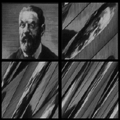
- “Nice one.”
Available from:
permalink | computing/archaic/afterdark | 2007.11.19-22:33.00
